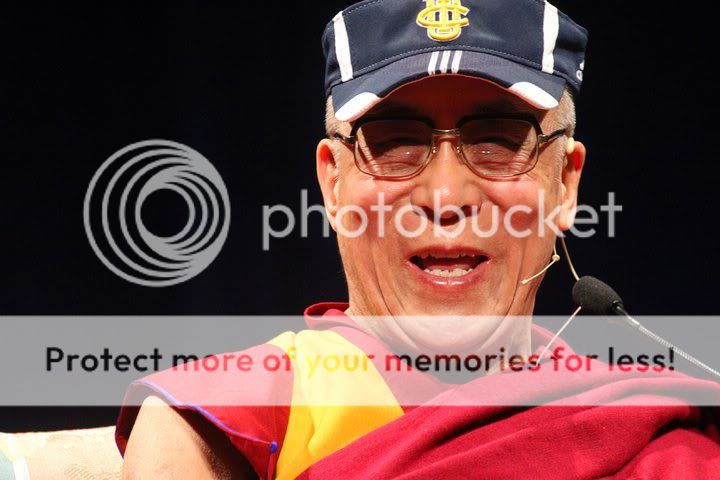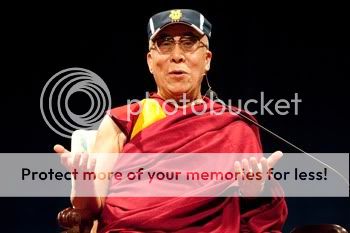Whenever I talk to people, [I have] no feeling of barriers, I feel like I’m talking to a long time friend.
~His Holiness, the 14th Dalai Lama of Tibet,* May 4, 2011

His Holiness, the 14th Dalai Lama of Tibet. May 4, 2011, at UCI. All photos via DayLife
NOTE: This is a lengthy post–sorry! I do realize that Buddhism invites us to simplify, but I had trouble distilling this entry to a smattering of pithy sayings. No worries if you’re too busy to read it right now; stop by when you’ve got time for a cuppa!
This past Wednesday, I went with my friend Stace to hear the Dalai Lama speak at UCI*. It was a sold-out event, and by the time we pulled into the parking lot, the outside temperature was 80 degrees and climbing. We staked our claim to a shaded berm near the front of the line–a diverse group of individuals that mirrored SoCal’s population: robed monks with shaved heads…a cluster of hijab-wearing women in flowing skirts…a platinum blonde in red-soled stilettos, eyes shielded by Chanel sunglasses…a grizzly old man, Sierra Club t-shirt barely covering his belly…a school girl, peppering her parents with questions.
A protester arrived. He paced up and down the sidewalk behind us, spewing hatred into a bullhorn. “Tibetan Buddhism is a false religion–an ignorant lie, spawned of Satan.” UCI students skirted around him, flip-flops slapping the pavement as they rushed to God-knows-where. They barely gave him any notice. He stabbed a picket sign in our general direction–a boldfaced collection of slogans and Bible verses that punctuated his sermon. There was a brief murmuring, followed by a smattering of boos. But then the doors opened, to everyone’s relief. After passing through (tight) security, we entered the non-judgmental world of the Dalai Lama.
A Tibetan singer invited us to participate in a moment of silent meditation; then, a group of Gaden Shartse monks performed a traditional Tibetan horn tribute, thus inviting His Holiness to join us. The Dalai Lama crossed the stage, bowing. We rose in unison, applauding. The Chancellor handed him a UCI visor, which the Dalai Lama immediately perched atop his head. Scarlet and saffron robes aside, doesn’t he resemble your favorite grandpa?

The Dalai Lama spoke with us for about 90 minutes. With the occasional assistance of a translator, he talked about compassion, global leadership, happiness, and interfaith harmony. His eyes twinkled, and his speech was infused with joy and humor. Laughter burbled from his belly the entire time, as if he were being tickled from the inside. [Note: A webstream video of this event is available here.]
Much of what he said was contextual–I suspect the takeaways were different for each listener. Still, and while I certainly don’t want to reduce this multi-dimensional event to a series of trivial sound bites, I’d like to share the highlights I scribbled in my journal. [All apologies for my ineloquent translation; also, ‘most everything here is paraphrased.]
*Money, fame, power, and a strong physical body are important. But the full development of healthy individual is dependent on inner strength. Inner strength could never be brought about through anger.
*Everybody wants –and has the same right to–happiness.
*Throughout history, many conflicts have taken place in the name of religion. The Dalai Lama believes it is absolutely wrong to use differences in philosophy or perspectives as reasons to initiate (or continue) conflicts.
*The underpinnings of all religions are similar, in that they value compassion, love and forgiveness.
*Unhappiness is of our own creation. “No one wants this problem,” he said, “yet they themselves create this problem.” It’s caused by too much stress, anxiety, fear, and frustration.
*“Your enemy is your real [true] teacher.”
*Emotions color our perspectives. They blur our understanding of the world’s complexities.
The Dalai Lama wove together examples from his own life and from history, returning always to our shared responsibility in bringing about world peace.
*”One reason [we have conflict],” he said, “is that we don’t look at things holistically. We focus on one small thing. Therefore, we are not objective.”
*Peace is a choice…one that’s worth it, every time.
*To bring about world peace, we must cultivate calm minds and warm hearts. “Warm-heartedness brings self-confidence, so our mind will be calm,” he said. “With a calm mind, we can use human intelligence properly.”
*“A compassionate mind thinks more about others,” he said. “That makes it very easy to communicate.” In developing compassion, we equip ourselves with the ability to rise above hate–to realize that we are more alike than different.
*Warm heartedness boosts self-confidence, which calms the mind. This gives us a clearer view of the world.
*”Self confidence doesn’t come from always being right,” he said. “It happens when we lose the fear of being wrong.”
*While religion helps its practitioners develop compassion, current events suggest we must also discover other means by which we can reach common objectives. The Dalai Lama emphasized the importance of respect, with regards to people of all religious persuasions. Similarly, he said, we must respect those who are nonbelievers. This coupling of ideals drew sustained applause from the audience.
“This is not a new idea from my mind,” he said. By way of example, he cited India’s 1,000-year tradition of respecting different religions. “Indian secularism includes respect for religious observers. Non-believers, too,” he added. This value/practice [secularism] is imbedded in India’s Constitution.
*While some of his Christian friends think secularism is disrespectful toward religion, the Dalai Lama does not subscribe to that belief.

At the end of his speech, the Dalai Lama took questions from students in the audience. When asked how he might encourage interfaith friendships and dialogue, His Holiness suggested 1) meeting with scholars from a variety of religious traditions, so as to learn from them; 2) meeting with religious practitioners, so as to seek common understanding; 3) visiting their holy sites and sacred spaces; and 4) taking pilgrimages together. Here, he talked about meditating under a Bodhi tree with Christians, Buddhists, Hindus, Muslims and Jews. “People with different philosophies and viewpoints often have the same purpose, the same goal,” he concluded, “We all want to be better, sensible human beings.”
A sociology undergraduate asked, “What is the secret to happiness?” The Dalai Lama paused. A grin spread across his face; his shoulders shook with inner mirth. “If there is a secret,” he finally said, “I must keep it.” But then he suggested that the shared aim of humanity is a happy world. A happy world depends on the existence of a healthy community, which in turn is based on a healthy family, which depends on healthy individuals living happy lives. And true happiness comes of living accordance with inner (and shared) values. Therefore — and now we’ve circled back to the beginning of his talk–as we become happy individuals, we bring about change in the world. He also encouraged us to “Provide maximum love and compassion to children…If we make some effort now, in the later part of the century we can produce very sensible compassionate leaders.”
Before exiting the stage, the Dalai Lama reminded that these are his personal thoughts, borne of over thirty years’ study and experience. Patience is key. If you expect too much, too soon, you are setting yourself up for feelings of failure. Practice in compassion, extending grace to yourself and others.
Many thanks to UCI and Center for Living Peace, co-sponsors of this amazing event. I’m grateful also for the opportunity to share this experience with you.
*In typical self-deprecating style, Tenzin Gyatso describes himself as “a simple Buddhist monk.” His official title is His Holiness the 14th Dalai Lama of Tibet, but most people simply call him “the Dalai Lama. A world-acclaimed Nobel Laureate, the Dalai Lama has met with presidents, prime ministers and crowned rulers of major nations. He also hosts international dialogues with world-renowned scientists and key figures from major religious sects. He has authored more than 50 books, including “The Art of Happiness” and “Toward a True Kinship of Faiths.”





